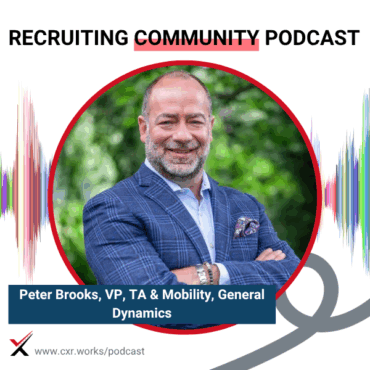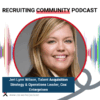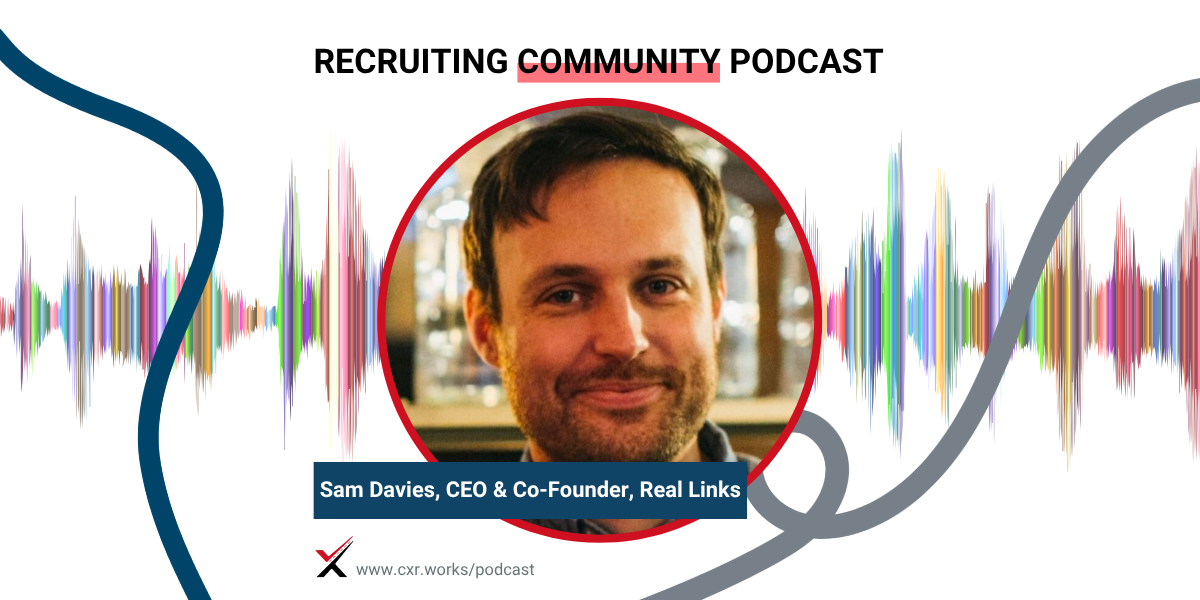
Positioning TA for What’s Next
Velocity is up. Budgets are tight. AI is everywhere. Peter Brooks shares how TA teams can adapt, automate, and stay human in a rapidly shifting business landscape.
 play_arrow
play_arrow
Building Internal Mobility & Operational Impact at Cox Enterprises Chris Hoyt
 play_arrow
play_arrow
6,500 Hires & Beyond: AI, Agility, & Talent Strategy at Fontainebleau Las Vegas Chris Hoyt
 play_arrow
play_arrow
Navigating AI Hype & Culture Shifts in TA Chris Hoyt
 play_arrow
play_arrow

Title:
Convergence of Employee Referrals & Advocacy Programs
Featured Guests:
Sam Davies, Founder and CEO, Real Links
Hosts:
Chris Hoyt, President, CareerXroads
Gerry Crispin, Principal and Co-founder, CareerXroads
Episode Overview:
Sam Davies, founder of Real Links, joins the CXR podcast to share how aligning employee referral and advocacy programs creates better candidate engagement, stronger hiring outcomes, and improved efficiency. From real-world case studies to platform strategy pivots, Sam explains why referrals and advocacy should be treated as one integrated effort—and how leading companies are already seeing results by doing just that.
Key Topics:
Origin of Real Links and early lessons from low engagement
Strategy shift to meet employees on familiar platforms (Teams, Slack, email)
Combining advocacy and referrals under one strategy
Case study: Great Western Railway’s 27% increase in female applicants
Importance of campaign-based over always-on messaging
Role of ERGs and employee authenticity in driving candidate interest
ATS integration and performance metrics from advocacy content
Organizational challenges when ownership of referrals and advocacy is split
Notable Quotes:
“Referrals and advocacy are solving the same problem—employee engagement.” — Sam Davies
“Instead of making employees come to us, we meet them where they are—Slack, Teams, email.” — Sam Davies
“The campaign with Women in Rail increased female applicants from 11% to 27%.” — Sam Davies
“Referrals are a form of advocacy.” — Sam Davies
“Some employees won’t put themselves out there—but when they do, it really opens the door.” — Sam Davies
Takeaways:
Real Links’ approach shows that simplifying and aligning referral and advocacy efforts can create measurable hiring outcomes, especially when embedded into employees’ daily communication channels. With better campaign planning and authentic employee voices, companies can reduce noise and increase both applicant quality and engagement.
Want more conversations like this?
Subscribe to the CXR podcast and explore how top talent leaders are shaping the future of recruiting. Learn more about the CareerXroads community at cxr.works.
Chris Hoyt: There we go. I just got back from a couple of weeks of what I’d call a “workation.” I was doing a little bit of work and a little bit of vacationing throughout Europe. But Sam, you’ve got some trips coming up, right?
Sam Davies: Yeah. Off to Amsterdam in a couple of weeks for an event over there on employee referrals. Then about a week and a half later, off to Berlin for the final event of the year. Two more to go, then rest time.
Chris Hoyt: Did you say you’re going to Amsterdam in a couple of weeks or for a couple of weeks?
Sam Davies: In a couple of weeks. My wife would kill me if it was for a couple of weeks. It’s for an employee referrals event over there—should be good.
Chris Hoyt: Very cool. Amsterdam is probably one of my favorite cities in the world. It’s just so fun, and the architecture’s great. I finally got to go to the Anne Frank House. I think I’ve been to Amsterdam five times and never could get tickets. This time we went in at like 6:30 or 7:00 at night. It was amazing.
Sam Davies: Yeah, it is.
Chris Hoyt: Canal trips are a little more lighthearted, but also pretty awesome.
Sam Davies: Yeah, they’re a lot of fun. It’s a great city. My wife and I were saying it’s one of the cities we’d consider living in for a while. It’s just such a lovely place.
Gerry Crispin: How’s Berlin, Sam? I hear it’s incredible with a lot of startups.
Sam Davies: Yeah, Berlin is really buzzy. From a startup perspective, it’s a great place to be—and it’s also just a fun city. It’s got a bit of everything. The startup ecosystem there is really happening.
Chris Hoyt: We’ve started a conversation—my partner and I—about where we might live for a year. Amsterdam could be one. Tokyo’s another. Could I live in Amsterdam long-term? Probably not. But a year? Absolutely.
Sam Davies: I just got back from Japan. We were there for a couple of weeks, and we were saying the same thing—living in Tokyo for a year would be unbelievable. Our kid is 14 months old, and we’d love to live somewhere for a few years while he’s young and we’ve got that freedom.
Chris Hoyt: Yeah, you’ve got to do it when they’re young enough not to have those deep friendships they’d hate to leave. There’s a sweet spot.
Sam Davies: Exactly. Before they start secondary school—or what you’d call high school.
Chris Hoyt: For sure. All right, we’ve got a couple of things to talk about. You guys ready to jump in?
Sam Davies: Gotcha.
Chris Hoyt: All right, here we go.
Announcer: Welcome to the CXR Channel—our premier podcast for talent acquisition and talent management. Listen in as the CXR community discusses a wide range of topics focused on attracting, engaging, and retaining the best talent. We’re glad you’re here.
Chris Hoyt: Welcome everybody to the Recruiting Community Podcast Show. I’m your host, and I have with me my guest co-moderator, partner in crime, spirit animal—Rachel!
Gerry Crispin: I’m wonderful! (laughs)
Chris Hoyt: It’s a Friends reference—a friendly opportunity.
Today, we’re talking with our industry friend Sam Davies, founder and CEO of Real Links. We’re diving into the convergence of employee referrals and advocacy programs—how Sam got there and what he’s learned.
But first, some quick housekeeping. We’re streaming on YouTube, Facebook, LinkedIn, Twitch. Past and future episodes are at cxr.works/podcast. If you’re watching on LinkedIn, say hi in the chat. Drop us questions—live or after the fact—we try to respond to everything.
Reminder: This is an ad-free labor of love. Nobody pays to be on this show. If they’re here, it’s because they’re friends of ours or they’re doing great work we want to showcase.
And don’t forget about the CXR Marketplace. It’s a living list of vendors and providers our TA community members are using—nearly 500 vendors now, with over 7,000 ratings and reviews. You can benchmark, build custom lists, and use our new radar feature that shows visual mapping of solution sentiment—based entirely on member reviews, not our opinions.
Also, if you’ve got end-of-year donation money, consider the CXR Foundation. We have an amazing board doing great work helping displaced TA leaders and professionals in transition. Use the QR code on screen or go to cxrfoundation.org.
Okay, let’s bring in Sam Davies. Hey Sam, how are you?
Sam Davies: Good, thanks!
Chris Hoyt: Let’s get a quick “elevator pitch.” Who is Sam Davies, and why are we listening to him today?
Sam Davies: Good question. I go through that with my therapist quite a bit! I started in philosophy and history at university, then moved into law—became a corporate lawyer. I got referred from one law firm to another, and that got me thinking about referrals. It wasn’t really being promoted or happening effectively, and I realized there was something that could be done here.
So I founded Real Links back in 2018. Initially, we focused on referrals—but engagement was always a challenge. We spent years learning, trying to build the perfect platform, but employees are overwhelmed with systems. So we flipped the model: instead of making employees come to us, we decided to meet them where they are—Slack, Teams, email, mobile.
When we did that, engagement skyrocketed. Then we thought: referrals and advocacy are solving the same problem—employee engagement. So why are they managed separately? Why aren’t the same teams or people overseeing both?
We started combining the two, and the results were compelling. And because we began in referrals, we already had the ATS integrations. That gave us deep metrics—applications, interviews, hires—on top of the usual likes and impressions from advocacy.
Chris Hoyt: That brings up a great case study from your team—Great Western Railway. Can you talk about that?
Sam Davies: Sure. They struggled to hire women in rail. So we partnered with their Women in Rail ERG and used Teams and mobile notifications to drive a campaign. They shared content about what it’s like to be a female driver, linked directly to job openings.
Their previous best for female hires was 11%. This campaign generated 27% female applicants. That’s what happens when you align referrals and advocacy—strategy, timing, and messaging all in sync.
Chris Hoyt: Are you seeing those light bulb moments with clients?
Sam Davies: All the time. When I first started talking about combining these, I thought I must be missing something—it seemed so obvious. But then I’d hear clients say, “Yeah, why haven’t we done that?” or “You mean marketing could use this too?”
Especially if you have someone skilled in recruitment marketing, that person should be driving both referrals and advocacy. Referrals are a form of advocacy.
Gerry Crispin: Are you also seeing candidates benefit—being better informed or able to trigger their own referrals?
Sam Davies: Yes, especially when employees are sharing authentic content. It makes the company seem more genuine and approachable. Some employees won’t want to put themselves out there, but when they do, it really opens the door for candidate engagement.
Chris Hoyt: What are some challenges clients face when merging referrals and advocacy?
Sam Davies: The biggest one is overwhelming employees. You’ve got one team asking them to share jobs, another asking them to share content—it becomes noise.
We found a campaign-based approach is more effective than always-on. Think of it like a content calendar. Align your efforts, send fewer, more targeted messages, and you get better results when and where you need them.
Chris Hoyt: Are you having any “told you so” moments?
Sam Davies: (laughs) I’m not that kind of guy. Every company is different. We’ll run side-by-side campaigns—one how they want to do it, one how we recommend. Then we look at the data together.
Chris Hoyt: We always ask: if you were going to write a book about what you’ve learned, what would the title be?
Sam Davies: Years Lost. (laughs) Maybe Years Lost, Years Gained. It’s been a rollercoaster. But I say that tongue-in-cheek—it’s been an awesome journey.
Chris Hoyt: Who gets the first signed copy?
Sam Davies: My wife. Though she probably wouldn’t read it—she’s lived it!
Chris Hoyt: Sam, much gratitude. You’re a busy guy on the other side of the planet. Always a pleasure to talk with you. We’re proud of the work you’re doing and excited to see what’s next.
Sam Davies: Thanks, Chris. Great to see you both.
Chris Hoyt: Everyone, we do this weekly. Join us at cxr.org/podcast. Until next time—cheers, everybody!
Announcer: Thanks for listening to the CXR channel. Please subscribe on your favorite podcast platform and leave us a review. Learn more at cxr.works, facebook.com/careercrossroads, and Instagram at @careerxroads. Catch you next time.
Tagged as: Podcast, ATS Integration, Employee Referrals, Real Links, ERGs, Diversity Recruiting, Slack, employee engagement, Teams, Talent Acquisition, Advocacy Programs, Company Culture, Great Western Railway, Advocacy Campaigns.
Chris Hoyt is the President of CareerXroads, a global peer community for talent acquisition leaders driving strategic change. With decades of experience leading recruiting innovation at Fortune 500 companies, Chris now advises enterprise TA teams on tech, process, and leadership. He’s a frequent speaker at conferences like SHRM, HR Tech, LinkedIn, and UNLEASH, and he’s known for pushing conversations beyond buzzwords to get to what really works in hiring. Through CXR, he connects top TA professionals to solve real problems, challenge norms, and shape the future of recruiting.

Velocity is up. Budgets are tight. AI is everywhere. Peter Brooks shares how TA teams can adapt, automate, and stay human in a rapidly shifting business landscape.

